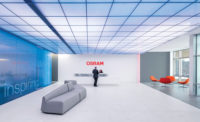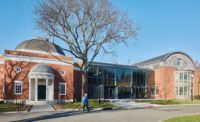Interviewed in his Tokyo office, the Japanese structural engineer reflects on the dramatic turn his work has taken since Toyo Ito's Sendai Mediatheque, nearly eight years ago.
The seemingly random arrangement of columns at Sendai, as well as the organic inspiration of seaweed transformed digitally into structure, suggests a strong precedent for the so-called “flux structure” that Sasaki designed for Isozaki’s Florence train station. He implemented a new shape-analysis approach, broadly described at the beginning of this article, that he calls Extended Evolutionary Structural Optimization (EESO). This is Sasaki’s own version of ESO (he added “Extended”), which is a relatively established methodology of efficient structural design in engineering. In a catalog for a 2007 exhibition of his work at London’s Architectural Association, Sasaki wrote that, with EESO, he uses “the principles of evolution and self-organization of living creatures, adapted from an engineering standpoint, to generate rational structural shapes within a computer.”
The constraints of the Florence station design called for the top roof to remain flat while the underside could fluctuate up to 40 feet below the roof surface for the span of the 1,300-by-130-foot structure. In the digital EESO model, Sasaki tweaked each individual component of a grid structure for the primary form (the flat roof plane) with localized forces until a web of “columns” emerged that not only addressed the targeted structural load profile, but did so with the least amount of materials. If it’s not quite turning Sendai on its side, it’s close. “We have to make a form that is reasonable,” says Sasaki. “And the computer makes that happen.”
While his design for Florence clearly relates to Sendai’s tubular columns, the details of Sendai’s steel-plate slabs conceal Sasaki’s other main interest: the pursuit of “pure form,” or the continuous surface as a structural element. At Sendai, a concrete topping slab hides those steel plates, but the thickness of the steel ribbing between each plate varies depending on shifting load conditions (thicker near the tube columns, thinner elsewhere). Sasaki implemented this “pure form” approach on a 2003 house in Tokyo, designed with Kazuyo Sejima (of SANAA), where the single structural and architectural surface consisted of 2-inch-thick steel plates. He laughs when he says the doors were thicker than the walls, but he’s not joking. The house exists as somewhat of a one-off model, but the approach has proved quite successful when transposed to concrete.
Working again with Ito, Sasaki designed a reinforced-concrete shell structure for the Kakamigahara Crematorium in Japan [RECORD, March 2007, page 166], which combines a billowing roof and columns into a single, uniform surface. “It’s not necessary to restrict material,” Sasaki says. “With this project, I wanted to take my theoretical studies and apply them.” A few years earlier in Fukuoka, Japan, Sasaki and Ito had collaborated on a similar project for a botanical garden—a flowing reinforced-concrete-shell structure with walkable, vegetated roofs. In her 2007 book, Support and Resist: Structural Engineers and Design Innovation, Nina Rappaport compares the garden building to a “piece of fabric that moves to spread and stretch in tension but then is stiffened for stability and captured, midmotion, at its most efficient form.”
Following his studies at Nagoya University and before founding his own firm in 1980, Sasaki worked for the great Japanese structural engineer Toshihiko Kimura, whose firm is known for its work with Isozaki, Fumihiko Maki, and Yoshio Taniguchi. Kimura’s 1989 design for the Tokyo Sea Life Park, an aquarium, with Taniguchi, includes a massive octagonal glass dome and several tensile fabric structures that indicate the willingness for experimentation and research as part of practice. Taken together with the engineer Masato Araya, of Structural Design Office OAK, and another one of Sasaki’s key sources of inspiration—the late Japanese structural engineer Yoshikatsu Tsuboi, who with Kenzo Tange designed Tokyo’s National Indoor Gymnasiums in 1964—you have the high-end of recent Japanese structural engineering.
Sasaki undoubtedly prizes this historical context, viewing his work as being within a tradition of design vanguard in Japan, in addition to that of European Modernism. To discuss one of his latest built projects, the Tama Library, designed with Ito, he leads not with an explanation of how he designed concrete fire-proofing around a steel-plate structure to form the project’s distinctive arches, but rather with the origins of the arch more than 3,000 years ago. “There has been nothing new with the arch since Roman times,” he says. “So, I went back to its origin and looked at it with 21st-century computer technology.”
Lately, Sasaki finds himself in an enviable position where he can say, “If it’s not interesting to me, then I don’t take the work.” His practice has also increasingly expanded to foreign work, including a museum at the University of California at Berkeley with Ito, as well as work with SANAA that includes the Ecole Polytechnique Fédérale Learning Center in Lausanne, Switzerland (EPFL), and New York’s New Museum (see page 132). The EPFL project expands the plate-structure approach that Sasaki employed on earlier museum projects with SANAA, warping them into a sloping interior landscape, like a topographical map of structural forces.
Further afield, Sasaki was recently asked to propose a conceptual structure for a project by the New York artists Christo and Jeanne-Claude. The Mastaba, first conceived in 1977 for the United Arab Emirates, will be a 492-foot-high, 738-foot-deep, and 984-foot-wide permanent structure of 390,500 stacked, empty oil barrels. Of the project, Sasaki says, “Architects have a reason to make a building, but with an artist, you have to take more time to understand the need to make the project.” He awaits a decision on whether his solution will be selected from a set of other proposals, but he is clearly delighted by the opportunity, saying, “These projects are sometimes beyond our description and imagination and can be a very big surprise to understand.”



Post a comment to this article
Report Abusive Comment